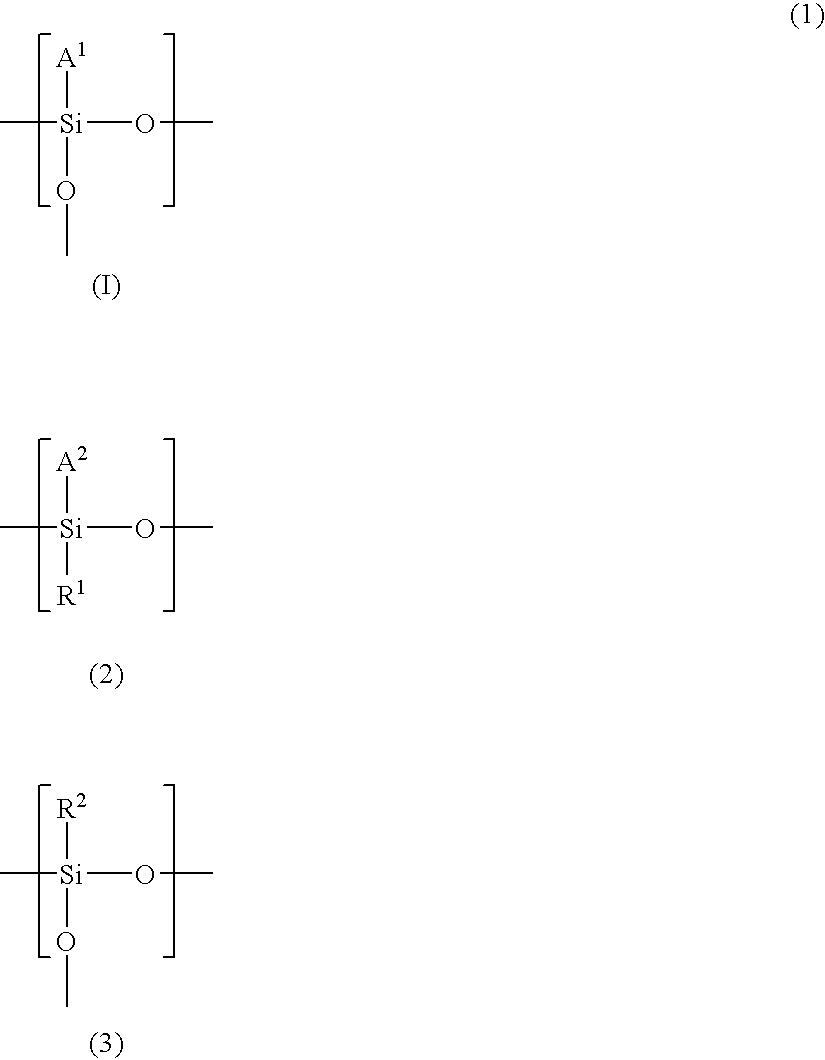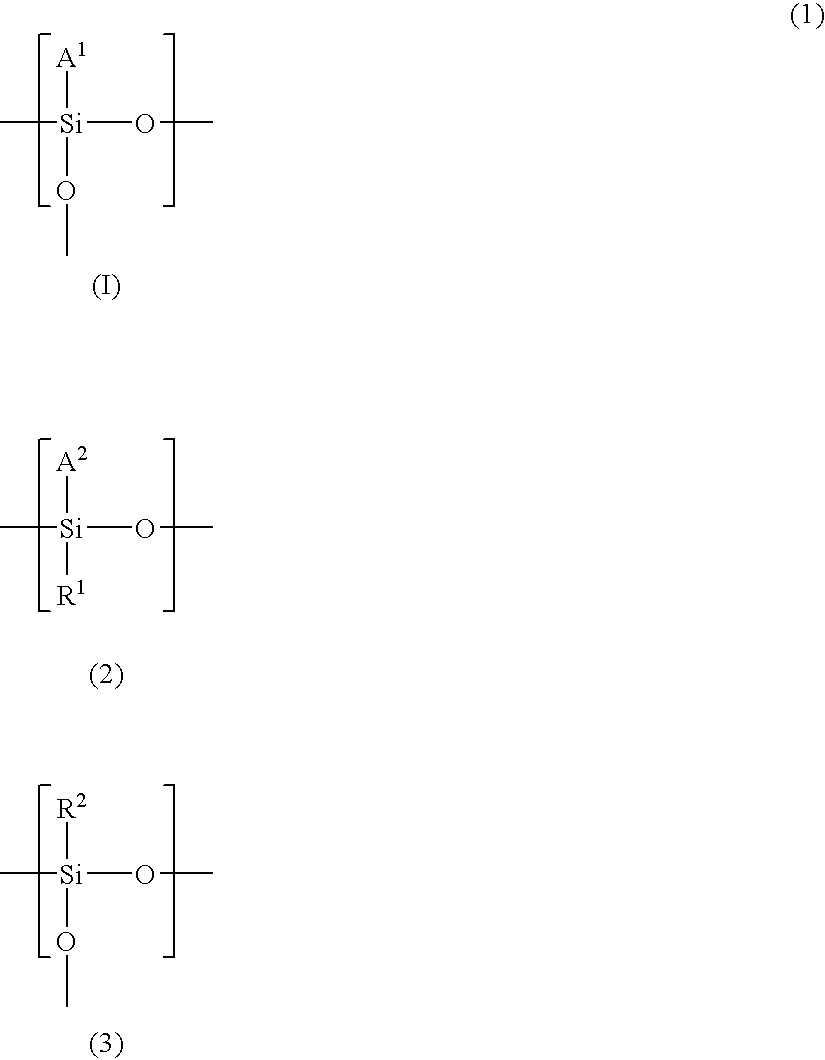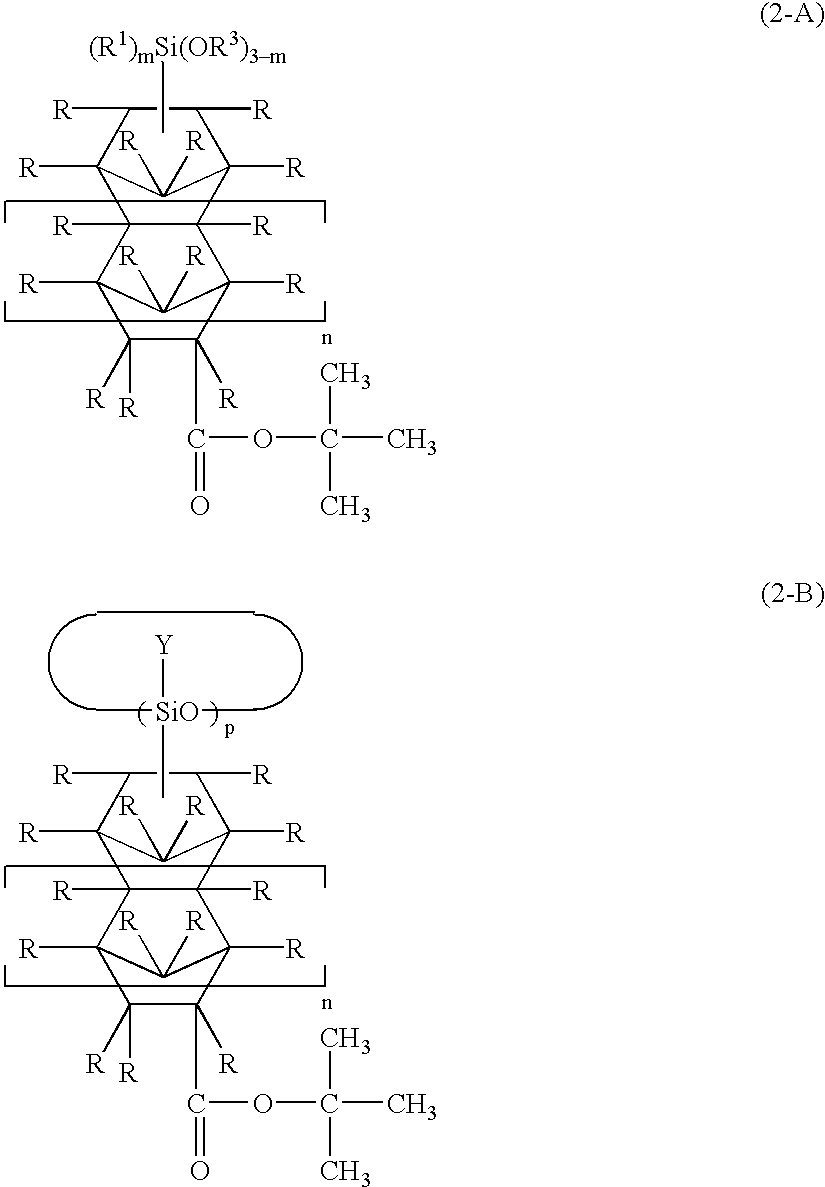Polysiloxane, method of manufacturing same, silicon-containing alicyclic compound, and radiation-sensitive resin composition
- Summary
- Abstract
- Description
- Claims
- Application Information
AI Technical Summary
Benefits of technology
Problems solved by technology
Method used
Image
Examples
synthesis example 1
Synthesis Silane Compound (6)
A three-necked flask equipped with a stirrer, a reflux condenser, and a thermometer was charged with 73.9 g of trimethoxysilane and 77.5 g of t-butyl acrylate. The mixture was stirred at room temperature and 0.1 ml of a 0.1 mol chloroplatinic acid (H2PtCl6) solution in isopropyl alcohol was added to initiate the reaction. After initiation of the reaction, the temperature increased as high as 60° C., then returned to room temperature. The mixture was stirred for three days at room temperature. After confirming that all raw materials substantially reacted, the reaction solution was filtered through celite by suction and the solvent was evaporated under vacuum to obtain an oily reaction product.
As shown by the following results of the measurement of NMR spectrum (chemical shift σ) and IR spectrum, the reaction product was identified to be 2-t-butoxycarbonylethyltrimethoxysilane.
σ: 3.6 ppm (methoxy group), 2.4-2.0 ppm (α-methylene group), 1.4 ppm (t-butyl gr...
example 1
Preparation of Polysiloxane (1)
A three-necked flask equipped with a stirrer, a reflux condenser, and a thermometer was charged with 9.7 g of 2-t-butoxycarbonylethyltrimethoxysilane prepared in Synthesis Example 1, 5.3 g of methyltrimethoxysilane, 1.3 g of hexamethyldisiloxane, 75 g of 4-methyl-2-pentanone, 4.2 g of distilled water, and 4.2 g of triethylamine. The mixture was reacted for three hours at 62° C. while stirring. The flask was cooled with ice and a solution of 11.1 g of oxalic acid in 200 ml of ion-exchanged water was added, followed by continued stirring. The reaction mixture was poured into a separating funnel to remove the water layer. 100 ml of ion-exchanged water was additionally added to wash the organic layer. After removing the water layer, the solvent was evaporated under vacuum to obtain polysiloxane (1).
NMR spectrum (chemical shift σ), IR spectrum, and Mw of the polysiloxane (1) were measured to confirm the following results.
σ: 2.4-2.0 ppm (α-methylene group), ...
example 2
Preparation of Polysiloxane (1)
A three-necked flask equipped with a stirrer, a reflux condenser, and a thermometer was charged with 6.3 g of 2-t-butoxycarbonylethyltrimethoxysilane prepared in Synthesis Example 1, 13.7 g of methyltrimethoxysilane, 4.1 g of hexamethyldisiloxane, 100 g of 4-methyl-2-pentanone, 9.1 g of distilled water, and 12.7 g of triethylamine. The mixture was reacted for three hours at 62° C. while stirring. The flask was cooled with ice and a solution of 1.7 g of oxalic acid in 200 ml of ion-exchanged water was added, followed by continued stirring. The reaction mixture was poured into a separating funnel to remove the water layer. 100 ml of ion-exchanged water was additionally added to wash the organic layer. After removing the water layer, the solvent was evaporated under vacuum to obtain polysiloxane (1).
NMR spectrum (chemical shift σ), IR spectrum, and Mw of the polysiloxane (1) were measured to confirm the following results.
σ: 2.4-2.0 ppm (α-methylene group)...
PUM
| Property | Measurement | Unit |
|---|---|---|
| Length | aaaaa | aaaaa |
| Length | aaaaa | aaaaa |
| Length | aaaaa | aaaaa |
Abstract
Description
Claims
Application Information
 Login to View More
Login to View More - R&D
- Intellectual Property
- Life Sciences
- Materials
- Tech Scout
- Unparalleled Data Quality
- Higher Quality Content
- 60% Fewer Hallucinations
Browse by: Latest US Patents, China's latest patents, Technical Efficacy Thesaurus, Application Domain, Technology Topic, Popular Technical Reports.
© 2025 PatSnap. All rights reserved.Legal|Privacy policy|Modern Slavery Act Transparency Statement|Sitemap|About US| Contact US: help@patsnap.com



